Generating attosecond pulses with controllable polarization from cyclic Hmolecules by bichromatic circular fields
Si-Qi Zhang(张思琪), Bing Zhang(张冰),†, Bo Yan(闫博),Xiang-Qian Jiang(姜向前),‡, and Xiu-Dong Sun(孙秀冬),2
1School of Physics,Harbin Institute of Technology,Harbin 150001,China
2Collaborative Innovation Center of Extreme Optics,Shanxi University,Taiyuan 030006,China
Keywords: high-order harmonic generation,attosecond pulse,multi-center interference
1.Introduction
High-order harmonic generation(HHG)serves as a tabletop source of the extreme ultraviolet (XUV) and soft x-ray light,which is a preferable method to obtain coherent radiation and attosecond pulses (APs).[1–4]Linear APs are restricted in probing chiral-sensitive light-matter interactions,[5,6]so it is desirable to generate APs with tunable polarization.Considerable efforts have been devoted to polarization control of harmonics in elliptically polarized (EP) fields,[7,8](nearly) orthogonally two-color polarized (OTC) fields,[9–11]and co-rotating bicircular fields.[12]Recently,the bichromatic counter-rotating circularly polarized (BCCP) field with frequencies (ω,2ω) has been proven to be an efficient laser scheme for generating the harmonics with large ellipticity.However, since the adjacent harmonics are counterrotating,[6,13,14]large intensity difference is required for extending BCCP scheme to generation of highly elliptical attosecond pulses.[13,15–17]For instance, Mediˇsauskaset al.pointed out that for p-type states of Ne atoms,large relative intensity of the adjacent harmonics leads to elliptical attosecond pulses both isolated and in a train.[16]In Ref.[17]the authors reported that a right-handed attosecond pulse train(APT)with an ellipticity up to 0.77 and a left-handed APT with an ellipticity of 0.45 can be generated from p-type state of Ne atoms.Until very recently,Dixitet al.obtained large relative intensity of the subsequent harmonics from atoms with ground states of s by tuning the relative amplitude ratio of the BCCP field and combining a seed XUV pulse.[18]
It is worth noting that most of the previous works used atoms as targets, but the nonspherical symmetry makes molecules become good candidates for generating(nearly)circularly polarized(CP)harmonics.[19–24]Liuet al.found that the allowed harmonics from stereoscopic molecules are sensitive to the molecular orientation which determines the rotational symmetry of the field-target system.[21]Wanget al.obtained a right-handed APT with an ellipticity of 0.78 by using the interference between harmonics from degenerate currentcarrying orbitals of the CH3Cl molecule.[22]In addition, researchers investigated the generation of harmonics from cyclic molecules Hq+n,and(nearly)CP harmonics are obtained.[23–25]To the best of our knowledge, the generation of the elliptical APTs using cyclic molecules under a BCCP field, however,has never been realized.In this work, we extend the BCCP scheme to a cyclic molecule target, and investigate polarization of harmonics from H2+3 molecular ions.It is found that,by choosing the rotation angle, large intensity difference appears in pairs of harmonics with alternate helicities in a wide energy region.The intensity difference can be described by a recombination model based on the quantum-orbit(QO)theory,which is associated with the multi-center interference.We also demonstrate the possibility of obtaining APTs with tunable ellipticity and helicity from H2+3 ,which can be extended to more complex molecules and various field configurations.For instance,one can utilize BCCP fields withω1/ω2=ω/2ωorω1/ω2=ω/5ωto irradiate a more stable benzene(C6H6)molecule[26,27]and synthesize elliptical APTs.
2.Theoretical methods


Fig.1.(a)The Lissajous curve of the BCCP field(ω,2ω)with amplitudes Eω =E2ω.The insets show RL-and LR-bicircular fields obtained by combining the ω and 2ω fields with different helicities.(b)A sketch of cyclic H2+3 molecular ions in the BCCP field at a rotation angle ϕ.The blue arrow represents the recombination direction of the electron;θk is the return angle of the electron relative to the x-axis;θ12,θ23 and θ13 are angles between internuclear vectors and the momentum of the return electron.[(c),(d)]The electronic density distributions of(c)the ground state|A′〉and(d)the degenerate excited states|E′±〉of H2+3.
wheref(t)is a trapezoidal envelope in duration of nine optical cycles(T0=2π/ω)and linear ramps of two cycles;Eω,E2ωandExuvare the amplitudes of the fundamental field, the 2ωfield and the seed XUV field,respectively;ζ=1 represents an RL-bicircular field(the fundamental field is right-handed(R)polarized and the 2ωfield is left-handed (L) polarized), andζ=-1 represents an LR-bicircular field.The Lissajous curve of the BCCP field withEω=E2ωin one optical cycle is shown in Fig.1(a).Here,ϕis the rotation angle of the driving field relative to the molecule illustrated in Fig.1(b)andR(ϕ)is the rotation matrix.


The TDSE is numerically solved by the split-operator method with the time step ∆t= 0.05 a.u.[30]The computation space isLx×Ly=204.8×204.8 a.u.with 1024×1024 grid points.At each time step, a mask function in the form of cos1/8has been used to avoid the unphysical reflection of the electron wave packet with an absorbing boundary 3Lx(y)/8.Once the dipole accelerationa(t)has been obtained,thex(y)component of the intensity of one harmonic with frequencyΩ=nωcan be obtained by

3.Results and discussions
Due to the symmetry compatibility of the field-target systems,[24,25]the 3n-order harmonics are forbidden for the three lowest states(|A′〉and|E′±〉)of H2+3.In the RL-bicircular field case, harmonics with orders (3n+1) are right-handed polarized, and with (3n-1) orders are left-handed polarized.Firstly, H2+3 is initially prepared on the ground state|A′〉 and is driven by an RL-bicircular field with intensitiesIω=I2ω=2×1014W/cm2(Eω=E2ω=0.075 a.u.) and with frequenciesω=0.057 a.u.(λ=800 nm), 2ω=0.114 a.u.(λ2=400 nm).By scanning the rotation angle, we find that the intensity difference between adjacent harmonics with alternating helicities depends on the rotation angleϕof the driving field and is large in a wide energy region atϕ=30◦.The harmonic spectraPx(y)(Ω) are presented in Fig.2(a).The cutoff order isNc=75ω, which is in good agreement with the prediction obtained by the recollision model of bicircular fields.[25]Figure 2(c) shows that the ellipticity of most harmonics deviates from perfect circular polarization (|εh|≤1),and this deviation originates from the imperfect overlap between thexandycomponents of the harmonics,which could be attributed to the temporal asymmetry caused by the fast variation of fields on the rising and falling edges.[33]The resolved harmonic components with right- and left-hand polarizations are shown in Fig.2(b)and the intensity difference of the adjacent harmonics oscillates with orders.However,from the insets, one can clearly see that the left-handed harmonics(blue short dot-dashed)are stronger than the right-handed ones(red solid)from 39th to 57th orders.Thus,elliptical APTs with left-handed polarization can be synthesized by using these harmonics,which will be discussed in detail later.
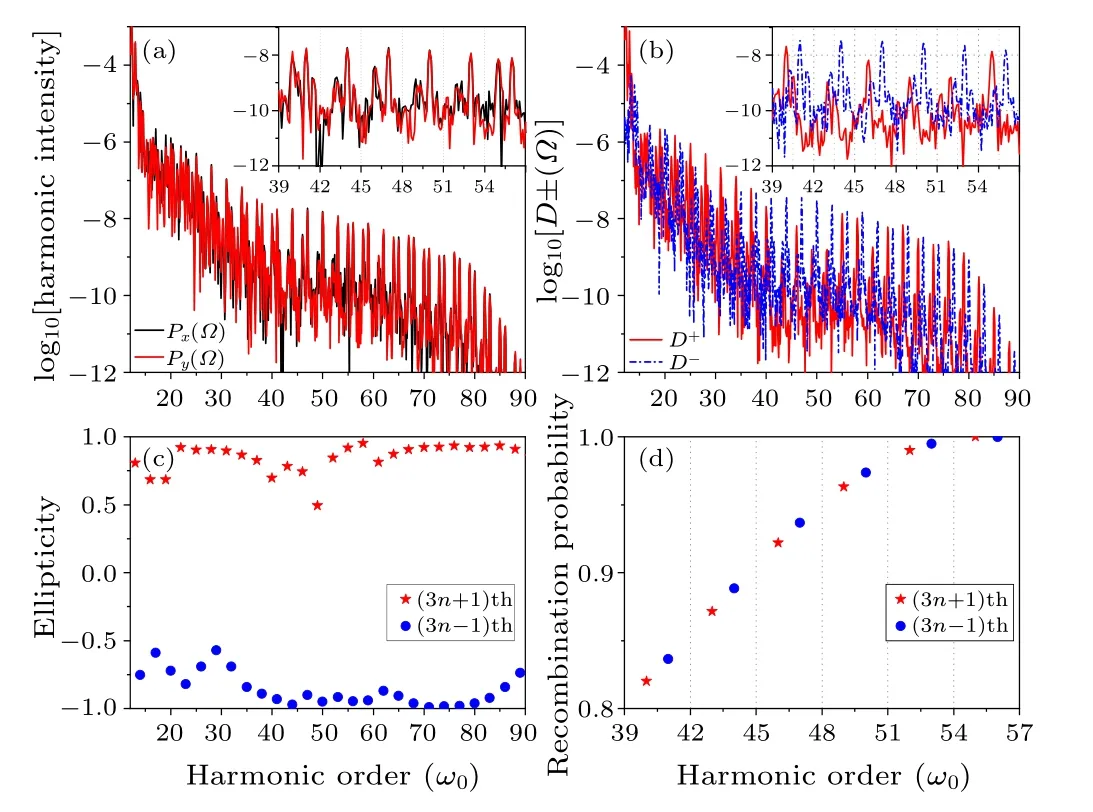
Fig.2.(a)Harmonic spectra Px(y)(Ω)from the ground state|A′〉of H2+3 in an RL-bicircular field with wavelengths λ =800 nm,λ2=400 nm at a rotation angle ϕ=30◦.The intensities of driving field are Iω =I2ω =2×1014 W/cm2 (Eω =E2ω =0.075 a.u.).(b)The resolved harmonic components with right and left-hand polarization D±.(c)Ellipticity of the allowed harmonics.(d) The recombination probability of the harmonics.The detailed harmonic spectra from 39th to 57th orders are shown in the insets.
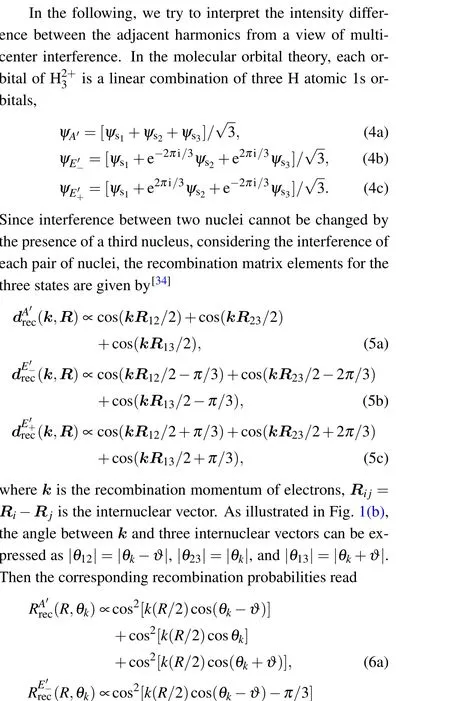

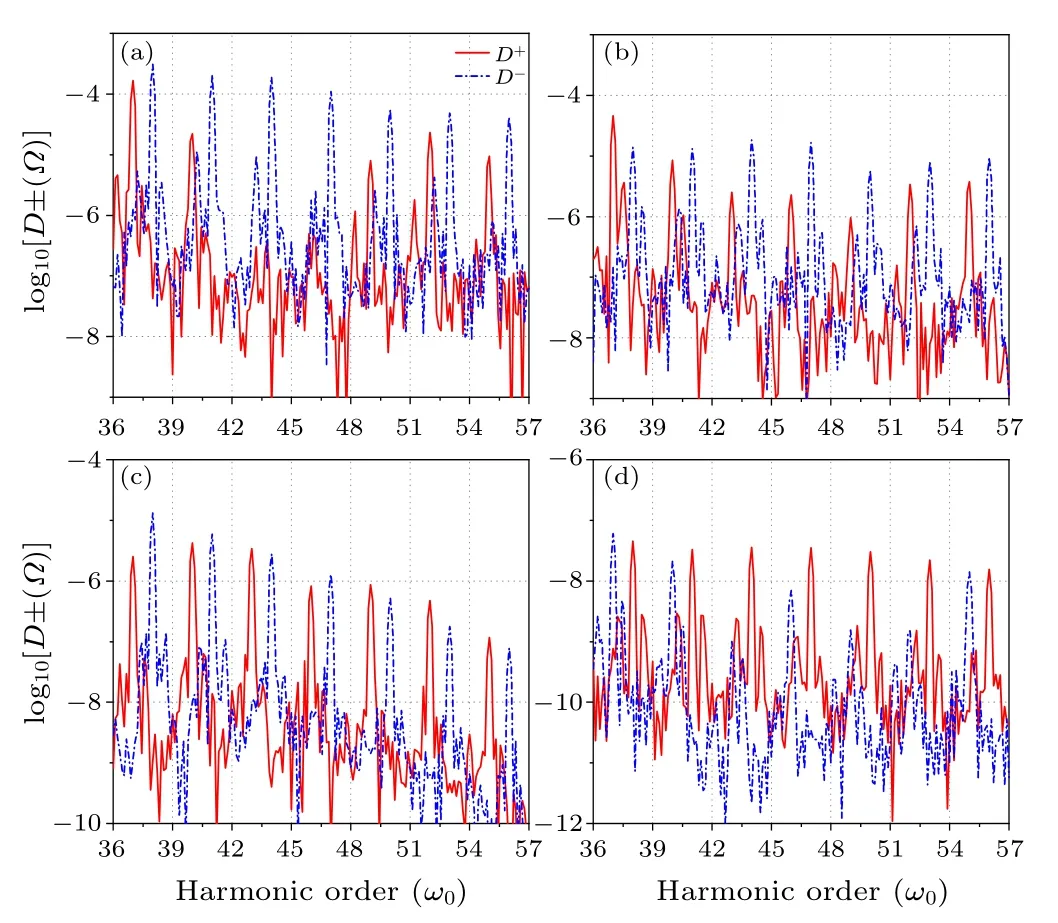
Fig.3.The resolved harmonic components with right and left-hand polarization D± from|A′〉state of the H2+3 driven by an RL-bicircular field, (a) in combination with a left-handed XUV field with frequency ωxuv =11ω, (b) in combination with a right-handed XUV field with frequency ωxuv =10ω, (c) for the amplitude of the 2ω field reduced to 2E2ω =Eω =0.075 a.u.and the right-handed XUV field still on.(d)The LR-bicircular field is used.Other laser parameters are the same as those in Fig.2
In the following,we try to control the intensity difference between adjacent harmonics by tailoring the BCCP field, so that we could obtain APTs with tunable polarization.We introduce an XUV field co-rotating with the 2ωfield to seed harmonic generation.This seed field could enhance the chance of absorbing photons from the 2ωfield versus theωfield,and its amplitude and frequency areExuv=0.01 a.u.andωxuv=11ω,respectively.The detailed harmonics in Fig.3(a)show that all harmonics are enhanced by the seed field, and the enhancement of left-handed harmonics is larger than that of the righthanded ones except for 50th and 53rd.As a result, the intensity difference between adjacent harmonics becomes larger and the ellipticity of the generated APTs increases.We mention that the 46th harmonic changes from the right-handed to left-handed polarization.That may be due to the fact that the driving field is not strictly three-fold rotational symmetric due to the presence of the seed field, and the symmetry breaking leads to the helicity reverse of specific harmonic.To obtain APTs with right-handed polarization, we need to make the right-handed harmonics dominant.Then,a right-handed XUV with frequencyωxuv=10ωis introduced,but the effect is not obvious.Most of the right-handed harmonics are enhanced slightly more than left-handed ones, but left-handed harmonics still dominate in the spectrum[see Fig.3(b)].To further enhance the right-handed harmonics,we reduce the amplitude of the 2ωfield to 2E2ω=Eω=0.075 a.u.to increase the chance of absorbing photons from theωfield.However,the reduction of 2ωfield only makes the intensities of the left- and righthanded harmonics comparable to each other [see Fig.3(c)].Finally,we have to change the helicity of the driving field and use an LR-bicircular field.In this case, (3n±1) harmonics with reversed helicities are produced and the right-handed harmonics become dominant[see Fig.3(d)],thus a right-handed polarized APT can be synthesized.From the above discussion, we can conclude that the introduction of an XUV field co-rotating with the stronger left-handed harmonics leads to the enhancement of the intensity difference of left-and righthanded harmonics, yielding left-handed polarized APT with a larger ellipticity.In addition,a right-handed polarized APT can be obtained by changing the helicity of the bicircular field.
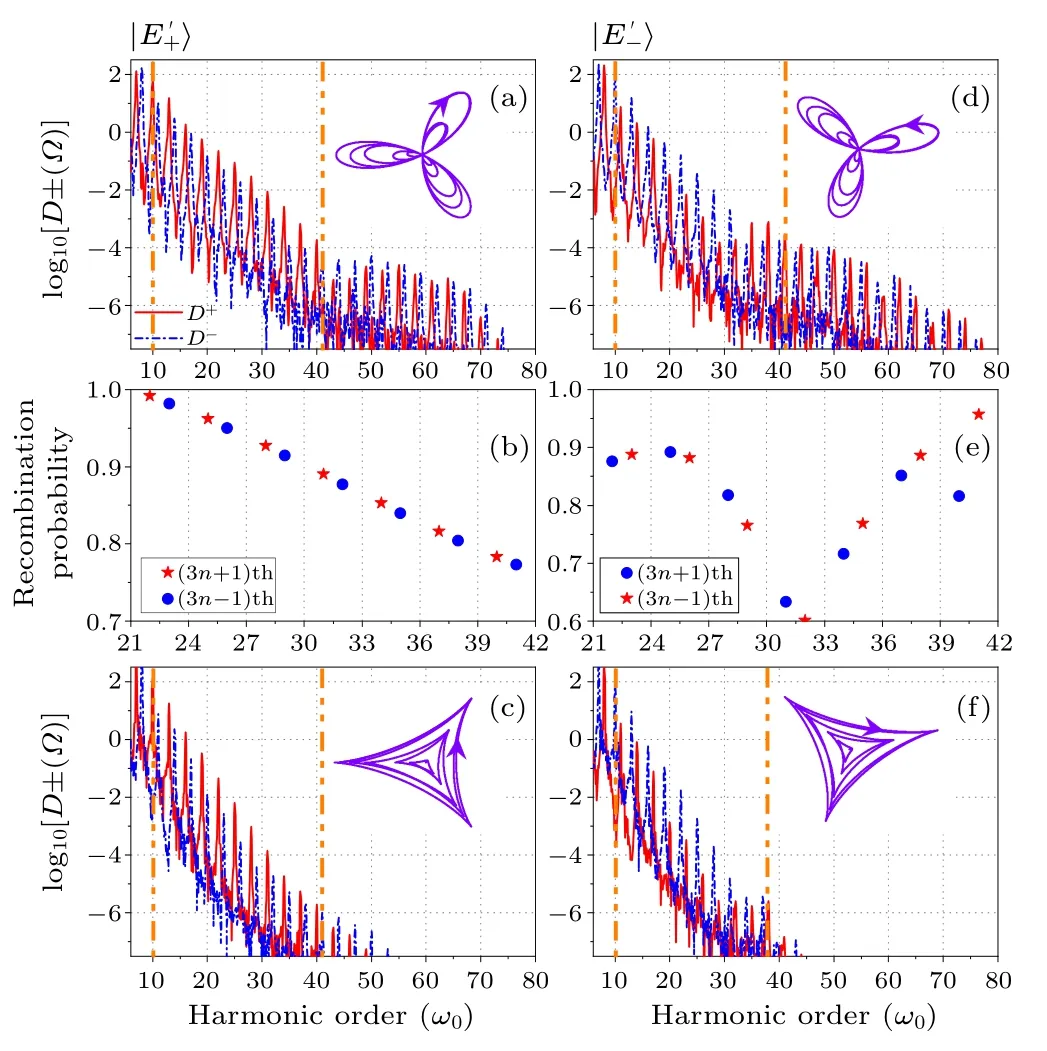
Fig.4.The resolved harmonic components with right and left-hand polarization D± from the |E′+〉 state of the H2+3 in RL-bicircular field at ϕ =60◦with amplitudes (a) Eω =E2ω =0.075 a.u., (c) 2E2ω =Eω =0.075 a.u.The resolved harmonic components D± from the|E′-〉state in LR-bicircular field at ϕ =15◦with(d)Eω =E2ω =0.075 a.u.,(f) 2E2ω =Eω =0.075 a.u.Other laser parameters are the same as those in Fig.2.The Lissajous curves of the electric fields are shown in the insets.The recombination probability of the harmonics(H21-H42)from(b)|E′+〉and(e)|E′-〉states.
Secondly,H23+is initially prepared on|E+′〉state,and we find that large intensity difference is achieved in a broad spectral range for|E′+〉 state under RL-bicircular field withϕ=60◦, where the right-handed (3n+1) harmonics are stronger than left-handed(3n-1)orders from 10th to 42nd orders,as shown in Fig.4(a).The recombination probability in Fig.4(b)shows the same tendency,so we can deduce that the prominent dominance ofp>qpathways in(3n+1)harmonics result in right-handed harmonics stronger than left-handed ones in this energy region.As is expected,when we reduce the amplitude of the 2ωfield to 2E2ω=Eω=0.075 a.u.,the dominance of right-handed harmonics is intensified [see Fig.4(c)].Analogously, an LR-bicircular field withϕ=15◦is used for the|E′-〉 state, in which the (3n+1) harmonics are left-handed polarized and(3n-1)harmonics are right-handed polarized,as shown in Fig.4(d).We can see that left-handed harmonics are stronger than right-handed ones from 10th to 32nd orders,and a reversed result can be observed from 33rd to 42nd orders.The recombination probability of harmonics in Fig.4(e)reproduces the trend again.When the 2ωfield is reduced to 2E2ω=Eω=0.075 a.u.,the energy region dominated by the left-handed harmonics extends to a range from 10th to 38th orders[Fig.4(f)].
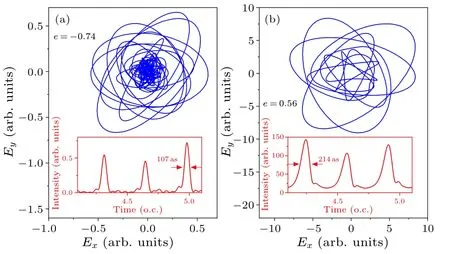
Fig.5.The electric fields of the APTs synthesized by harmonics (a)from the|A′〉state under an RL-bicircular field with amplitudes Eω =E2ω =0.075 a.u.in combination with a left-handed XUV field,(b)from the|E′+〉state under an RL-bicircular field with 2E2ω =Eω =0.075 a.u.The insets show temporal profiles of the APTs.
According to the above discussion, we have obtained large intensity difference between adjacent harmonics with alternating helicities in a wide energy region by tailoring the bicircular field.APTs with high ellipticity can be synthesized by using these harmonics, and we present two typical results in Fig.5.The ellipticity of the APTs can be defined ase=(|E+|2-|E-|2)/(|E+|2+|E-|2),[17]whereE+andE-are calculated by integrating the two counter-rotating componentsof the electric field over a temporal window(4.1–5.1 optical cycles).Firstly,by superposing 37th to 56th harmonics from the|A′〉 state under an RL-bicircular field [Fig.2(b)], we obtain a left-handed polarized APT with an ellipticity ofe=-0.59 (not shown here).As mentioned above,using a left-handed XUV as the seed field can improve the intensity difference between adjacent harmonics.Consequently, a left-handed polarized APT with an ellipticity up toe=-0.74 is generated [Fig.5(a)].From the inset, we can see that there are three attosecond bursts in one optical cycle,and the duration of the most intense burst is 107 as, which is shorter than the one up to 213 as long we obtained from H+2molecules under an OTC field.[38]Figure 5(b) presents electric field of the APT obtained by superposing 10th to 35th harmonics from the|E′+〉 state under an RL-bicircular field with 2E2ω=Eω=0.075 a.u.[Fig.4(c)],a right-handed polarized APT withe=0.56 is obtained and the duration of the most intense burst is 214 as.Our simulations show the viability of extending the BCCP scheme to molecule targets,and the control of the harmonic chirality inherently allows one to manipulate the polarization of the generating APTs.
4.Conclusions
In summary, we theoretically study the harmonic radiation from cyclic Hmolecular ions under tailored BCCP fields with frequencies(ω,2ω)by numerically solving TDSE.Due to compatible symmetry of the field and molecular orbital, the allowed harmonics with(3n±1)order are counterrotating to each other.Our simulations show that large intensity difference between adjacent harmonics in a wide energy range can be obtained by choosing the rotation angles of the BCCP field.The intensity difference is interpreted by using a recombination model, and we deduce that the strong recombination corresponds to an intense ionization process related to certain pathways.In other words, harmonics co-rotating with the fundamental field are dominant when the pathways corresponding to electrons absorbing more photons from the fundamental field show prominent dominance,and vice versa.To further control the ellipticity and helicity of the synthesized APTs, we tailor the BCCP fields by introducing XUV pulse,reducing the amplitude of 2ωfield, or even changing the helicity of the driving field.Using these methods,a left-handed APT with an ellipticity up to 0.74 and a right-handed APT with an ellipticity of 0.56 are obtained.Our work would provide a reference for manipulating the polarization of the generating APTs in molecular systems.
Acknowledgments
This work was supported by the National Natural Science Foundation of China (Grant No.91950117) and the Fundamental Research Funds for the Central Universities.
- Chinese Physics B的其它文章
- Unconventional photon blockade in the two-photon Jaynes–Cummings model with two-frequency cavity drivings and atom driving
- Effective dynamics for a spin-1/2 particle constrained to a curved layer with inhomogeneous thickness
- Genuine entanglement under squeezed generalized amplitude damping channels with memory
- Quantum algorithm for minimum dominating set problem with circuit design
- Protected simultaneous quantum remote state preparation scheme by weak and reversal measurements in noisy environments
- Gray code based gradient-free optimization algorithm for parameterized quantum circuit

